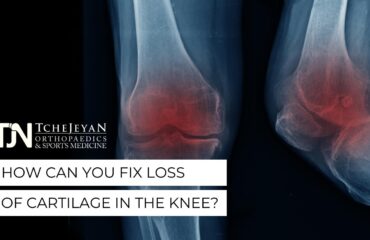When you stop to think about it, our knees really take a beating. We use them every day, and they have to bear the weight not just of standing but walking, running, climbing stairs, sports activities, kneeling, crouching, and standing up. It’s no wonder that knee injuries are very common.
However, when you injure your knee, it is frequently difficult to tell what part of the knee is damaged and what the nature of the injury is. Your knee is a complex joint, so self-diagnosing your condition is difficult. Consequently, if you’re suffering from knee pain, especially acute or chronic pain severely limiting your mobility, you need to know what’s wrong. A diagnosis from a knee specialist is the best way to pinpoint the cause so you can treat the injury, heal, and hopefully resume your normal activities soon.
What Are the Symptoms of Patellar Tendonitis?
The anatomical name for your kneecap is the patella. When your pain seems to be primarily concentrated in the kneecap, you can often assume that you have a patellar injury. But what kind of injury? Unfortunately, many knee injuries exhibit similar symptoms: pain, swelling, stiffness, weakness, redness, and tenderness.
The patella is one of the three bones of the knee joint. Ligaments connect the patella to the other bones, and tendons attach the patella to the surrounding muscles. All of these components work together to keep the knee stable, and injury to any of these parts can compromise the integrity of the joint. A patellar injury could be a fracture, dislocation, tendon tear, ligament tear, or tendonitis.
Patellar tendonitis will make it painful to walk, run, jump, or bend or straighten your knee. The area at the front of the knee may be swollen and tender to the touch.
If you think you’re suffering from patellar tendonitis, schedule an appointment with a physician who can provide you with an accurate diagnosis. During your appointment, your physician will examine your knee, and ask you about the symptoms you are experiencing, when you started experiencing these symptoms, what activities you engage in, and your medical history. Depending on the severity of your condition, your physician may order an MRI or other imaging test to evaluate the injury.
What Causes Tendonitis of the Patella?
Many people who experience patellar tendonitis mistake this knee injury for a torn tendon. However, tendonitis is not the same thing. Tears usually happen from a single injury event after a jump or turn, and the injury causes immediate and acute pain. In contrast, although tendonitis can be similarly painful, it tends to develop gradually over time from repetitive movement of the knee or a period of overuse, such as when you undertake a new exercise regimen, resume a sport after a period of inactivity, or begin a job that requires climbing or bending and lifting. Tendonitis is often called “jumper’s knee” because the stress on the tendon from repeated jumping on a hard surface, such as a tennis or basketball court, can cause tendonitis to develop.
How Is It Treated?
The good news is that, unlike many knee injuries, tendonitis of the patella rarely requires surgery. If you are diagnosed with tendonitis, the most effective method for treating tendonitis is simple: rest the knee. However, as simple as that sounds, it is sometimes difficult. For an active person, forced rest is not easy, and since you need to use your knees to get around, it can be inconvenient. But it is necessary; continuing to use your knee will only prolong the tendonitis and may even worsen the pain and stiffness. To the extent possible, follow the RICE method: rest, ice, compression, and elevation. The sooner you begin this treatment and the more diligently you adhere to it, the sooner you can get back to your regular activities.
If you’re suffering from knee pain or a knee injury, TJN Orthopaedics and Sports Medicine can help. Dr. T, the LA Knee Guy, will diagnose your condition and prescribe the appropriate treatment so you can return to your activities as soon as possible. Contact us today at TJN Ortho to learn more about our services and to schedule your first appointment.




